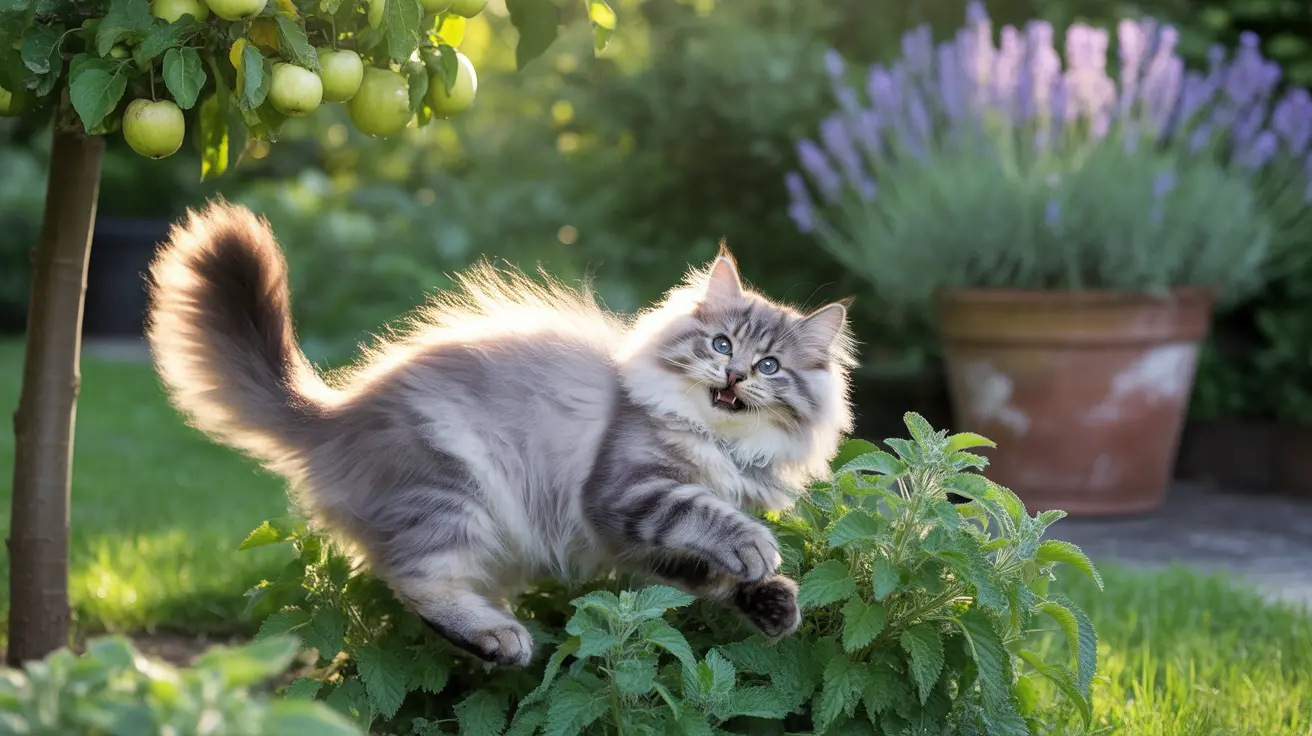A fluffy gray and white Siberian cat playfully sprawled on green leafy plants in a sunlit garden
{
"title": "The Complete Guide to Catnip: How This Herb Influences Your Cat",
"subtitle": "Discover the science, benefits, and safe use of catnip to enrich your cat's life and well-being.",
"name_en": "The Complete Guide to Catnip: How This Herb Influences Your Cat",
"news_category": "behavior-training",
"short_description": "Explore how catnip influences cat behavior, its benefits, safety, and uses for enhancing your cat's life.",
"long_description": "
Catnip has long fascinated both cat owners and researchers due to its remarkable effects on feline behavior. This mysterious herb, scientifically known as Nepeta cataria, has earned its place as one of the most intriguing natural substances in the world of pet care. But what exactly makes this plant so special, and why do our feline friends react to it in such unique ways?
From promoting playful behavior to offering therapeutic benefits, catnip has proven to be more than just a recreational treat for our feline companions. Its complex interaction with cat biology and its various practical applications make it an invaluable tool for pet owners seeking to enhance their cats' well-being.
In this comprehensive guide, we'll explore everything you need to know about catnip, from its scientific properties to practical applications, ensuring you can make informed decisions about incorporating it into your cat's life.
Understanding the Catnip Plant
Nepeta cataria, commonly known as catnip, belongs to the mint family (Lamiaceae). This perennial herb thrives in North America, characterized by its light green, fuzzy foliage and delicate lavender-colored flowers. Catnip is not only famous for its effects on cats, but it has also been used throughout history in herbal remedies for humans, as well as a natural insect repellent due to its aromatic oils. Its hardy nature and ease of growth make it a popular plant among gardeners and those interested in organic pet care solutions.
How Catnip Works: The Science Behind the Magic
The secret behind catnip's effects lies in its active compound, nepetalactone. This organic chemical is found in the leaves and stems of the plant and interacts with cats' vomeronasal organ, which is located in the roof of their mouth. When cats sniff, chew, or rub against catnip, nepetalactone binds to special receptors, triggering neural responses that mimic feline pheromones. This unique process explains the range of behavioral changes observed in cats exposed to catnip.
Understanding Catnip Behavior
Cats typically display a range of fascinating reactions to catnip. These may include:
- Rolling and rubbing against the herb
- Increased playfulness and energy
- Purring and vocalization
- Relaxation or zoning out
- Occasional mild aggression during play
Each cat may react differently depending on their genetics and mood. Some may become hyperactive and pounce on toys, while others prefer to lounge peacefully or purr contentedly. These behaviors typically last for about 10–15 minutes, after which a refractory period occurs before the cat can experience the effects again. Observing your cat's behavior can help you determine the best way to incorporate catnip into their enrichment routine.
Catnip Uses and Applications
Modern catnip products are available in a variety of forms to suit different needs and preferences:
- Fresh herbs: Ideal for gardeners who want to grow catnip in their own yards, providing a continual, organic source for their pets.
- Dried catnip: Commonly used to refill toys or for easy sprinkling on scratchers and play areas to encourage active engagement.
- Catnip sprays: Convenient for applying to surfaces such as furniture or scratching posts to redirect attention and prevent unwanted behavior.
- Specialized catnip toys: Designed to enrich your cat’s environment and promote exercise and mental stimulation.
Each form offers unique advantages, and pet owners can experiment with them to discover what works best for their individual cat. Integrating catnip products into playtime or as part of training can increase bonding and provide valuable enrichment.
Therapeutic Benefits of Catnip
Beyond recreation and play, catnip provides several therapeutic advantages for feline health and welfare:
- Stress and anxiety reduction: Catnip’s calming effects can help alleviate stress during changes in the home environment, travel, or visits to the vet.
- Natural pain relief properties: Some studies suggest catnip may have mild analgesic effects, offering comfort to cats experiencing minor aches or discomfort.
- Behavioral modification aid: By using catnip as a positive reinforcement, undesirable behaviors such as inappropriate scratching or aggression can be redirected.
- Digestive support: When ingested in small amounts, catnip may help soothe minor digestive upset and promote a sense of well-being.
Catnip for Anxiety Management
Many cat owners successfully use catnip to help manage their pets' anxiety during stressful situations like travel, veterinary visits, or sudden environmental changes. The herb's natural calming properties make it a gentle alternative to pharmaceutical interventions. Sprinkling catnip on bedding or in carriers can help create a positive association and reduce fear or nervousness, ensuring that your cat feels more secure and at ease.
Catnip Safety and Dosage Guidelines
While catnip is generally safe, responsible use is important to prevent unwanted effects or loss of efficacy:
- Offer small amounts, such as 1 tablespoon of dried catnip at a time.
- Carefully monitor your cat’s unique reaction to ensure it stays positive and playful.
- Limit exposure to a couple times a week to avoid tolerance, where the cat becomes less responsive over time.
- Store catnip in a cool, airtight container to maintain its potency and freshness.
It’s important to note that some cats may experience mild digestive upset if they consume large quantities, so moderation is key. If you notice any adverse reactions, discontinue use and consult your veterinarian for guidance.
Special Considerations for Different Age Groups
Catnip for Kittens
Most kittens under six months of age show no reaction to catnip, as the genetic sensitivity required typically develops as they mature. Once they reach the appropriate age, catnip can be introduced safely in small amounts. Early, moderate exposure can provide opportunities for interactive play and training.
Catnip for Senior Cats
Older cats may continue to benefit from catnip into their senior years, although their sensitivity may decrease as they age. Providing catnip can help promote mental stimulation and encourage gentle physical activity, both of which contribute to a senior cat’s overall well-being.
Frequently Asked Questions
- What is catnip? Catnip is a herb known for its stimulating effects on cats.
- How does catnip affect cats? Catnip often induces playful, energetic, or relaxed behavior in cats, depending on their sensitivity and the form of catnip used.
- Is catnip safe for all cats? Yes, catnip is considered safe for cats of all ages when used in moderation. Always observe your cat’s reaction before making catnip a regular part of their routine.
- Why do some cats not respond to catnip? Sensitivity to catnip is hereditary, and about a third of cats show no reaction due to a lack of the specific gene required to respond to nepetalactone.
- What is the active ingredient in catnip? Nepetalactone is the compound in catnip that affects cats, responsible for the classic behavioral changes.
- Can kittens use catnip? Most kittens under three to six months old do not have the genetic sensitivity required to respond to catnip. It is safe to introduce once they are older and you observe a reaction.
- Are there therapeutic uses for catnip? Catnip can help relieve minor stress, anxiety, or behavioral issues and serve as a gentle adjunct to training.
- What forms does catnip come in? Catnip is available as dried leaves, sprays, oils, and toys infused with catnip extract, allowing for versatile use in enrichment and training.
- Can cats overdose on catnip? Overexposure can occasionally cause mild digestive upset, such as vomiting or diarrhea, but is rarely dangerous. Remove access and consult a veterinarian if symptoms persist.
- How often can I give catnip to my cat? It’s recommended to offer catnip a couple times a week to prevent desensitization and maintain its effectiveness.
Understanding catnip's effects, benefits, and proper usage can help you make the most of this fascinating herb. Whether you're looking to provide enrichment, manage anxiety, or simply treat your feline friend, catnip offers a safe and natural option for enhancing your cat's quality of life. Remember to observe your cat's individual response and consult with your veterinarian if you have specific concerns about incorporating catnip into your pet care routine.
Catnip has long fascinated both cat owners and researchers due to its remarkable effects on feline behavior. This mysterious herb, scientifically known as Nepeta cataria, has earned its place as one of the most intriguing natural substances in the world of pet care. But what exactly makes this plant so special, and why do our feline friends react to it in such unique ways?
From promoting playful behavior to offering therapeutic benefits, catnip has proven to be more than just a recreational treat for our feline companions. Its complex interaction with cat biology and its various practical applications make it an invaluable tool for pet owners seeking to enhance their cats' well-being.
In this comprehensive guide, we'll explore everything you need to know about catnip, from its scientific properties to practical applications, ensuring you can make informed decisions about incorporating it into your cat's life.
Understanding the Catnip Plant
Nepeta cataria, commonly known as catnip, belongs to the mint family (Lamiaceae). This perennial herb thrives in North America, characterized by its light green, fuzzy foliage and delicate lavender-colored flowers. Catnip is not only famous for its effects on cats, but it has also been used throughout history in herbal remedies for humans, as well as a natural insect repellent due to its aromatic oils. Its hardy nature and ease of growth make it a popular plant among gardeners and those interested in organic pet care solutions.
How Catnip Works: The Science Behind the Magic
The secret behind catnip's effects lies in its active compound, nepetalactone. This organic chemical is found in the leaves and stems of the plant and interacts with cats' vomeronasal organ, which is located in the roof of their mouth. When cats sniff, chew, or rub against catnip, nepetalactone binds to special receptors, triggering neural responses that mimic feline pheromones. This unique process explains the range of behavioral changes observed in cats exposed to catnip.
Understanding Catnip Behavior
Cats typically display a range of fascinating reactions to catnip. These may include:
- Rolling and rubbing against the herb
- Increased playfulness and energy
- Purring and vocalization
- Relaxation or zoning out
- Occasional mild aggression during play
Each cat may react differently depending on their genetics and mood. Some may become hyperactive and pounce on toys, while others prefer to lounge peacefully or purr contentedly. These behaviors typically last for about 10–15 minutes, after which a refractory period occurs before the cat can experience the effects again. Observing your cat's behavior can help you determine the best way to incorporate catnip into their enrichment routine.
Catnip Uses and Applications
Modern catnip products are available in a variety of forms to suit different needs and preferences:
- Fresh herbs: Ideal for gardeners who want to grow catnip in their own yards, providing a continual, organic source for their pets.
- Dried catnip: Commonly used to refill toys or for easy sprinkling on scratchers and play areas to encourage active engagement.
- Catnip sprays: Convenient for applying to surfaces such as furniture or scratching posts to redirect attention and prevent unwanted behavior.
- Specialized catnip toys: Designed to enrich your cat’s environment and promote exercise and mental stimulation.
Each form offers unique advantages, and pet owners can experiment with them to discover what works best for their individual cat. Integrating catnip products into playtime or as part of training can increase bonding and provide valuable enrichment.
Therapeutic Benefits of Catnip
Beyond recreation and play, catnip provides several therapeutic advantages for feline health and welfare:
- Stress and anxiety reduction: Catnip’s calming effects can help alleviate stress during changes in the home environment, travel, or visits to the vet.
- Natural pain relief properties: Some studies suggest catnip may have mild analgesic effects, offering comfort to cats experiencing minor aches or discomfort.
- Behavioral modification aid: By using catnip as a positive reinforcement, undesirable behaviors such as inappropriate scratching or aggression can be redirected.
- Digestive support: When ingested in small amounts, catnip may help soothe minor digestive upset and promote a sense of well-being.
Catnip for Anxiety Management
Many cat owners successfully use catnip to help manage their pets' anxiety during stressful situations like travel, veterinary visits, or sudden environmental changes. The herb's natural calming properties make it a gentle alternative to pharmaceutical interventions. Sprinkling catnip on bedding or in carriers can help create a positive association and reduce fear or nervousness, ensuring that your cat feels more secure and at ease.
Catnip Safety and Dosage Guidelines
While catnip is generally safe, responsible use is important to prevent unwanted effects or loss of efficacy:
- Offer small amounts, such as 1 tablespoon of dried catnip at a time.
- Carefully monitor your cat’s unique reaction to ensure it stays positive and playful.
- Limit exposure to a couple times a week to avoid tolerance, where the cat becomes less responsive over time.
- Store catnip in a cool, airtight container to maintain its potency and freshness.
It’s important to note that some cats may experience mild digestive upset if they consume large quantities, so moderation is key. If you notice any adverse reactions, discontinue use and consult your veterinarian for guidance.
Special Considerations for Different Age Groups
Catnip for Kittens
Most kittens under six months of age show no reaction to catnip, as the genetic sensitivity required typically develops as they mature. Once they reach the appropriate age, catnip can be introduced safely in small amounts. Early, moderate exposure can provide opportunities for interactive play and training.
Catnip for Senior Cats
Older cats may continue to benefit from catnip into their senior years, although their sensitivity may decrease as they age. Providing catnip can help promote mental stimulation and encourage gentle physical activity, both of which contribute to a senior cat’s overall well-being.
Frequently Asked Questions
- What is catnip? Catnip is a herb known for its stimulating effects on cats.
- How does catnip affect cats? Catnip often induces playful, energetic, or relaxed behavior in cats, depending on their sensitivity and the form of catnip used.
- Is catnip safe for all cats? Yes, catnip is considered safe for cats of all ages when used in moderation. Always observe your cat’s reaction before making catnip a regular part of their routine.
- Why do some cats not respond to catnip? Sensitivity to catnip is hereditary, and about a third of cats show no reaction due to a lack of the specific gene required to respond to nepetalactone.
- What is the active ingredient in catnip? Nepetalactone is the compound in catnip that affects cats, responsible for the classic behavioral changes.
- Can kittens use catnip? Most kittens under three to six months old do not have the genetic sensitivity required to respond to catnip. It is safe to introduce once they are older and you observe a reaction.
- Are there therapeutic uses for catnip? Catnip can help relieve minor stress, anxiety, or behavioral issues and serve as a gentle adjunct to training.
- What forms does catnip come in? Catnip is available as dried leaves, sprays, oils, and toys infused with catnip extract, allowing for versatile use in enrichment and training.
- Can cats overdose on catnip? Overexposure can occasionally cause mild digestive upset, such as vomiting or diarrhea, but is rarely dangerous. Remove access and consult a veterinarian if symptoms persist.
- How often can I give catnip to my cat? It’s recommended to offer catnip a couple times a week to prevent desensitization and maintain its effectiveness.
Understanding catnip's effects, benefits, and proper usage can help you make the most of this fascinating herb. Whether you're looking to provide enrichment, manage anxiety, or simply treat your feline friend, catnip offers a safe and natural option for enhancing your cat's quality of life. Remember to observe your cat's individual response and consult with your veterinarian if you have specific concerns about incorporating catnip into your pet care routine.






